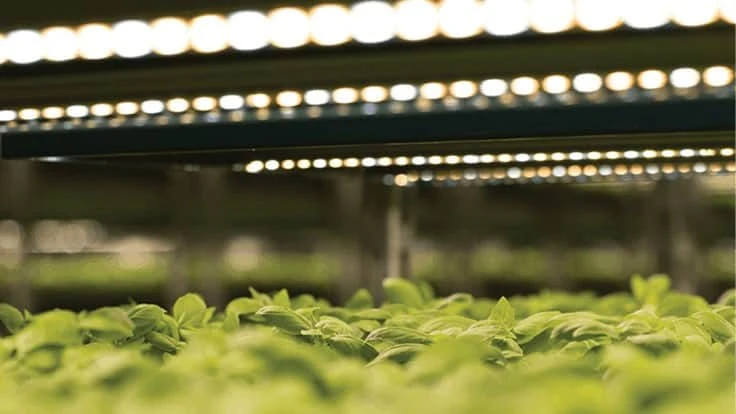

More than a half a decade before the recent rise in lighting providers, Shenandoah Growers headquartered in Harrisonburg, Virginia, was on the cutting edge of the supplemental lighting trends.
Shenandoah Growers is a 25-year-old company that grows, packs and distributes high-quality culinary herbs and leafy greens from its facilities throughout the United States. Shenandoah Growers leverages virtually every commercially scalable CEA growing practice (indoor, greenhouse, vertical, etc.) in its quest to be the world’s leading consumer brand of affordable, quality indoor grown organic fresh produce.
“We were looking for a company that we could partner with to develop lighting solutions for our indoor grow rooms, as well as our greenhouse production,” says Robert “Bob” Hoffman, chief science officer. “Now we are using Fluence LED lighting solutions all across the board in our indoor farms, plug production, nursery and greenhouse plants, as well as in all phases of our vertical farming systems.”
Shenandoah worked in conjunction with Fluence by OSRAM in codeveloping the manufacturers’ popular Razr Series, which the company describes as “a sleek LED lighting system tailored for the world’s largest and densest vertical farming systems.”
So why Fluence? In today’s lighting market, choosing a provider amongst competing solutions is often easier said than done. In Shenandoah’s case, they went with a company that provided the flexibility they were seeking.
“They were willing to customize and build something that would suit our needs,” Hoffman says. “They were a young, progressive company that was flexible in their design. They worked with us to give us the spectrums we were looking for, and they made sure the light fixtures fit into our automation, not the other way around.”
_USE_THIS_PER_CLIENT_fmt.png)
The first need Fluence was able to help Shenandoah address was a custom solution for its plug production processes.
“For plug production, we want to develop a very strong, yet compact seedling with a strong root system that has the extra energy it needs so that the plants will initiate rooting immediately after transplant,” Hoffman says. “We did that together. We did experiments, lighting trials, and then we modified those trials, and then we just kept going and working to satisfy the spectrum (needs of the crop) as well as to satisfy the efficiency of the lighting.”
Prior to working with Fluence, Shenandoah used what Hoffman calls “the older, magnetic ballast HPS lights.”
“We were maybe getting around 1 micromole per joule of electricity with those [old HPS], and with these new lights we’ve replaced them with we’re seeing about a 2.5x increase in efficiency,” he says. “That’s quite a nice increase on efficiency and it’s saved us a ton on operating expenses.”
And the story goes on as plans remain in place for the two industry giants to continue working together to bring fresh, safe, locally grown produce to Shenandoah’s customers.
“We are always working with our lighting partners to test new spectrums, get more efficiency and more profitability out of our LED lighting,” Hoffman says. “Fluence has proven themselves to be a valued partner for Shenandoah Growers.”

Explore the September 2020 Issue
Check out more from this issue and find your next story to read.
Latest from Greenhouse Management
- North Carolina Nursery & Landscape Association announces new executive vice president
- Plant Development Services, Inc. unveils plant varieties debuting in 2025
- Promo kit available to celebrate first National Wave Day on May 3
- Applications now open for American Floral Endowment graduate scholarships
- Endless Summer Hydrangeas celebrates 20 years with community plantings
- Invest in silver
- Garden Center magazine announces dates for 2025 Garden Center Conference & Expo
- USDA launches $2 billion in aid for floriculture growers





